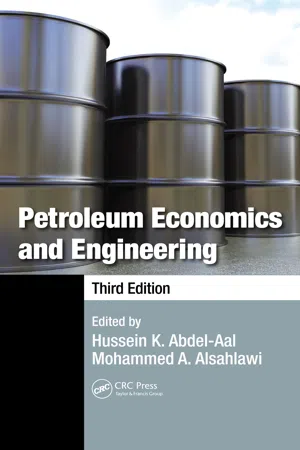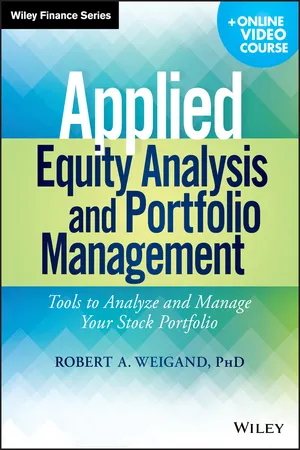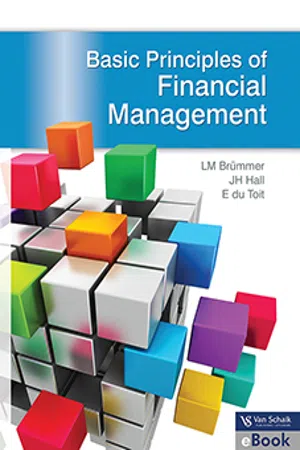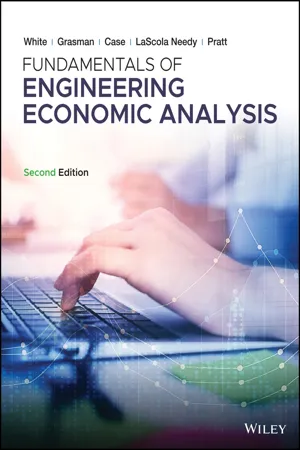Business
Time Value of Money
The time value of money is the concept that money available today is worth more than the same amount in the future due to its potential earning capacity. This principle is based on the idea that a dollar received today can be invested and earn interest, making it more valuable than a dollar received in the future. It is a fundamental concept in finance and investment decision-making.
Written by Perlego with AI-assistance
Related key terms
1 of 5
10 Key excerpts on "Time Value of Money"
- eBook - PDF
- Hussein K. Abdel-Aal, Mohammed A. Alsahlawi(Authors)
- 2013(Publication Date)
- CRC Press(Publisher)
69 4 Time Value of Money (TVM) in Capital Expenditures M. Bassyouni This chapter is devoted to an examination of some basic relationships that relate interest to a given capital of money (either expenditure or income) over a given period of time. It is essential to consider the effect time has on capital, as capital must always produce some yield. Time Value of Money (TVM) is the value of money figuring at a given amount of interest earned over a given amount of time. TVM is the central concept in finance theory . CONTENTS 4.1 Basic Definitions .......................................................................................... 70 4.1.1 Capital Investment ........................................................................... 70 4.1.2 Interest ............................................................................................... 70 4.2 Types of Interest ........................................................................................... 71 4.3 Interest Calculation ...................................................................................... 71 4.4 Effective Interest .......................................................................................... 73 4.5 Annuities and Periodic Payments ............................................................. 76 4.5.1 Derivation of the Basic Equation (Sinking Fund Factor) ............ 77 4.5.2 Applications of the Annuity Technique ....................................... 78 4.5.2.1 Determining the Annual Depreciation Costs ............... 78 4.5.2.2 Determining the Annual Capital Recovery Costs ....... 78 4.6 Capitalized Costs ......................................................................................... 81 4.6.1 Calculation of Capitalized Costs of an Asset to Be Replaced Perpetually ....................................................................... - eBook - ePub
Applied Equity Analysis and Portfolio Management
Tools to Analyze and Manage Your Stock Portfolio
- Robert A. Weigand(Author)
- 2014(Publication Date)
- Wiley(Publisher)
APPENDIX The Time Value of Money and the Basics of ValuationT his tutorial introduces a set of tools that allows you to value a stream of cash flows in different time periods. The skill set featured in this chapter lies at the heart of what differentiates finance from other business disciplines—the ability to analyze the value of an asset, a financial security, or an entire company. While all the major finance principles are relevant to this topic, the main principle that's in play is Principle 1, Value = The Present Value of Expected Future Cash Flows, depicted in Figure A1.1 .FIGURE A1.1 Value = The Present Value of Expected Future Cash Flows.If the cash flows represented in the diagram are those expected to be paid out by a financial contract, like a bond, a mortgage, or a car loan, then the present value of those cash flows is what the contract should be worth—a concept we'll call “intrinsic value.” The same idea applies if the cash flows are expected to be earned by a new corporate investment or the entire firm itself.Once the time-value-of-money (TVM) tools are mastered, we'll be able to combine several tools to solve real-world problems, such as the financial planning problem depicted in Figure A1.2 . Here we're estimating the present value of someone's desired annual retirement income (R) on the likely date of their retirement (20 years from now) to obtain what financial planners call their “number”: how much they will need to have saved so they can live well during retirement. Once we have an estimate of how much they'll need to accumulate (the value of the R's in time period 20), we can make another projection using future value - eBook - ePub
- Brümmer LM, Hall JH, Du Toit E(Authors)
- 2017(Publication Date)
- Van Schaik Publishers(Publisher)
1439The Time Value of Money
Learning outcomes
After studying this chapter, you should- fully grasp the meaning of the Time Value of Money
- understand the concepts of future and present values
- know how to calculate future and present values
- understand the concepts of the future and present value of annuities
- know how to calculate the future and present value of annuities
- understand the concept of amortisation.
Introduction
Although at first glance the Time Value of Money may not appear to be related to the reading and analysis of financial statements, it has a direct bearing on the financial statements. To explain this remark, let us find an example that would require application of the principle of the Time Value of Money.Let us consider the investment of working capital in accounts receivable, one of the current assets in the Statement of Financial Position. When an organisation allows its debtors to buy on credit, the organisation is, in effect, making an investment in accounts receivable because the organisation’s money will be tied up or invested in accounts receivable until the debtors pay their accounts. The investment ends when debtors settle their accounts, and accounts receivable finally become cash.The concept of the Time Value of Money
When debtors settle their accounts late, the time value of the money invested in accounts receivable becomes important. The concept of the Time Value of Money simply means that it is more profitable, and therefore preferable, to receive money now rather than at some time in the future. 144There are two reasons for this preference. The first concerns risk. The longer a creditor has to wait for his money, the greater is the chance or risk that some problem will arise to cause financial loss. An example of such a problem would be the debtor being declared insolvent before paying his debt.The second reason concerns the opportunity cost of capital. Most investors prefer to invest their funds as soon as possible in order to receive a return as quickly as possible from the most profitable investment opportunities available. When investors have to wait too long, they stand to lose opportunities in the present - eBook - PDF
Entrepreneurial Finance for MSMEs
A Managerial Approach for Developing Markets
- Joshua Yindenaba Abor(Author)
- 2016(Publication Date)
- Palgrave Macmillan(Publisher)
Part IV Valuation 259 © The Author(s) 2017 J.Y. Abor, Entrepreneurial Finance for MSMEs, DOI 10.1007/978-3-319-34021-0_11 11 Time Value of Money Learning Objectives By the end of this chapter, you should be able to: • appreciate the concept of ‘Time Value of Money’ • compare simple and compound interest • calculate future value lump sum and prevent value lump sum • distinguish between effective rate and stated rate • explain and calculate perpetuities • calculate future and present values based on annuities • distinguish between ordinary annuity and annuity due • explain and calculate amortisation 11.1 Introduction The concept of Time Value of Money deals with the fact that ‘a dollar today is worth more than a dollar tomorrow’. This means it will take more future dollars than current dollars to buy the same quantity of goods and services because of the effect of inflation. If you have the opportunity to receive US$2,000 today or US$2,000 in a year from today, which would you prefer? Naturally, you would take the US$2,000 today because you recognise the Time Value of Money. Receiving the US$2,000 today gives you the opportunity to invest the money in order to earn interest. In a year’s time you are likely to receive an amount bigger than the US$2,000. Assuming the US$2,000 can be put in fixed deposit with interest rate of 16 % per annum. Then, the value of the investment after one year will be worth US$2,000 plus US$320 or US$2,320. We got the interest amount of US$320 by multiplying the interest rate of 16 % by the principal of US$2,000. The dollar of US$2,000 today is obviously worth more than the US$2,000 in future. For you to be convinced to part with your money for some time, you would need to be convinced of a rate of interest. In a world where there is certainty in all cash flows, the rate of interest can be used to express the time of money. With the rate of interest, it is possible to adjust the cash flows to any particular point in time. - eBook - PDF
- Robert Parrino, David S. Kidwell, Thomas Bates, Stuart L. Gillan(Authors)
- 2021(Publication Date)
- Wiley(Publisher)
The idea that money has a time value is one of the most fundamen- tal concepts in the field of finance. The concept is based on the idea that most people prefer to consume goods today rather than wait to have similar goods in the future. Since money buys goods, they would rather have money today than in the future. Thus, a dollar today is worth more than a dollar received in the future. Another way of view- ing the Time Value of Money is that your money is worth more today than at some point in the future because, if you had the money now, you could invest it and earn interest. Thus, the Time Value of Money is the opportunity cost of forgoing consumption today. Applications of the Time Value of Money focus on the trade-off between current dollars and dollars received at some future date. This is an important element in financial decisions because most investment decisions require the comparison of cash invested today Concluding Comments This chapter has introduced the concept of Time Value of Money and the basic principles of present value and future value. The table at the end of the chapter summarizes the key equa- tions developed in the chapter. The equations for future value (Equation 5.1) and present value (Equation 5.4) are two of the most fundamental relations in finance and will be applied throughout the rest of this textbook. Before You Go On 1. What is the difference between the interest rate (i) and the growth rate (g) in the future value equation? APPLICATION 5.6 Calculating Projected Earnings Problem Disney’s net income in 2019 was $11.05 billion. Wall Street analysts expect Disney’s earn- ings to increase by 1.55 percent per year over the next three years. Using your financial calculator, determine what Disney’s earnings should be in three years. Approach This problem involves the growth rate (g) of Disney’s earnings. We already know the value of g, which is 1.55 percent, and we need to find the future value. - eBook - PDF
- Robert Parrino, David S. Kidwell, Thomas Bates(Authors)
- 2016(Publication Date)
- Wiley(Publisher)
147 LEARNING OBJECTIVES 1. Explain what the Time Value of Money is and why it is so important in the field of finance. 2. Explain the concept of future value, including the meaning of principal amount , simple interest and compound interest , and be able to use the future value formula to make business decisions. 3. Explain the concept of present value and how it relates to future value, and be able to use the present value formula to make business decisions. 4. Discuss why the concept of compounding is not restricted to money, and be able to use the future value formula to calculate growth rates. When you purchase a car from a dealer, the decision of whether to pay cash or use a loan to finance your purchase can affect the price you pay. For example, when mar-ket conditions are tough, automobile manufacturers often offer customers a choice between a cash discount and low-cost financing. Both of these alternatives affect the cost of purchasing a car, but one alternative can be worth more than the other. To see why, consider the following. In September 2014, the automobile manufac-turer Kia Motors wanted to increase sales of its Soul model in the Arabian Gulf. The company offered consumers a choice between (1) receiving AED4 500 off the base price of AED50 000 if they paid cash and (2) receiving 0 per cent financing on a three-year loan if they paid the base price. For someone who had enough cash to buy the car outright and did not need the cash for some other use, the decision of whether to pay cash or finance the purchase of the Soul depended on the rate of return that they could earn by investing the cash. On the one hand, if it was possible to earn only a 3 per cent interest rate by investing in a bank deposit, the buyer was better off paying cash. On the other hand, if it was possible to earn 5 per cent, the buyer was better off taking the financing. With a 4 per cent rate of return, the buyer would have been largely indiffer-ent between the two alternatives. - eBook - ePub
- Robert Irons(Author)
- 2019(Publication Date)
- Routledge(Publisher)
2 Time Value of MoneyThe material covered in this chapter is the framework upon which the rest of the chapters in the book are built. The conception of the Time Value of Money gets at the very heart of virtually every calculation done from this point forth. That is because the calculations used are driven by the fundamental principles, as will be seen.This chapter covers the mathematical methods (and formulas) used to calculate the value of cash flows when either pushing them out in time (to calculate a future value) or pulling them back in time (to calculate a present value). The methods take into account the fact that corporations use other people’s money (from debtors or common stock holders) to fund their operations, and those investors deserve to be paid for the use of their money.The Cost of Money
Like everything else in life, money has a cost; that is, raising money costs money. Corporations raise money in two general forms: debt (borrowing money) and equity (selling partial ownership in the firm). The cost of debt is interest. To the borrower, the interest rate represents cost, while to the lender the interest rate represents income (known as its yield or return). Equity has two costs: dividends (quarterly payments of cash) and capital gains (increases in the stock’s market price). To the firm these are costs, while to the firm’s shareholders they are income. So, the total yield paid to equity holders can be broken down into the dividend yield and the capital gains yield. The cost of debt is discussed in detail in Chapter 4 , “The Term Structure of Interest Rates.” The costs of equity are discussed further in Chapter six , “Stock Valuation.”The Fundamental Principles in Action
FP1 equates the value of an asset with the present value of the cash flows the asset is expected to produce. This principle is clearly seen when calculating the present value of single or multiple cash flows, and is applied (but not so clearly) when calculating the present value of annuities. FP3 asserts the inverse relationship between the price of an asset and its yield, or return. This principle is seen when discounting is done more frequently than annually—this effectively increases the discount rate, causing the present value of the cash flows to decrease. The interaction between FP1 and FP3 is seen in PR1, which states that increasing the discount rate decreases the present value of cash flows. - eBook - PDF
- Timothy Mayes(Author)
- 2020(Publication Date)
- Cengage Learning EMEA(Publisher)
229 C H A P T E R 8 “A bird in the hand is worth more than two in the bush.” That old aphorism, when translated into the language of finance, becomes “A dollar today is worth more than a dollar tomorrow.” Intuitively, it probably makes sense, but why? Stated very simply, you can take that dollar today and invest it with the expectation of having more than a dollar tomorrow. Because money can be invested to grow to a larger amount in the future, we say that money has a “time value.” This concept of a Time Value of Money underlies much of the theory of financial decision making, and you will be required to understand this material in order to complete the remaining chapters. The Time Value of Money L E A R N I N G O B J E C T I V E S : After studying this chapter, you should be able to: LO1 Explain the concept of the Time Value of Money. LO2 Calculate the present value and future value of cash flows using Excel. LO3 Explain the types of cash flows encountered in financial analysis and how to adjust for each type in making time value calculations in Excel. LO4 Differentiate between the alternative compounding periods, and use Excel to compare present and future values under different compounding schemes. Copyright 2021 Cengage Learning. All Rights Reserved. May not be copied, scanned, or duplicated, in whole or in part. Due to electronic rights, some third party content may be suppressed from the eBook and/or eChapter(s). Editorial review has deemed that any suppressed content does not materially affect the overall learning experience. Cengage Learning reserves the right to remove additional content at any time if subsequent rights restrictions require it. CHAPTER 8 The Time Value of Money 230 Future Value Imagine that you have $1,000 available to invest. If you earn interest at the rate of 10% per year, then you will have $1,100 at the end of one year. - eBook - PDF
Managerial Accounting
Tools for Business Decision Making
- Jerry J. Weygandt, Paul D. Kimmel, Donald E. Kieso(Authors)
- 2015(Publication Date)
- Wiley(Publisher)
Would you rather receive $1,000 today or a year from now? You should prefer to receive the $1,000 today because you can invest the $1,000 and then earn interest on it. As a result, you will have more than $1,000 a year from now. What this example illustrates is the concept of the Time Value of Money . Everyone prefers to receive money today rather than in the future because of the interest factor. APPENDIX PREVIEW Time Value of Money Appendix A 1 Compute interest and future values. • Nature of interest • Future value of a single amount • Future value of an annuity 2 Compute present values. • Present value variables • Present value of a single amount • Present value of an annuity • Time periods and discounting • Present value of a long-term note or bond 3 Compute the present value in capital budgeting situations. • Using alternative discount rates 4 Use a financial calculator to solve Time Value of Money problems. • Present value of a single sum • Present value of an annuity • Useful financial calculator applications LEARNING OBJECTIVES 1 Compute interest and future values. LEARNING OBJECTIVE Nature of Interest Interest is payment for the use of another person’s money. It is the difference between the amount borrowed or invested (called the principal ) and the amount repaid or collected. The amount of interest to be paid or collected is usually stated as a rate over a specific period of time. The rate of interest is generally stated as an annual rate. The amount of interest involved in any financing transaction is based on three elements: 1. Principal ( p ): The original amount borrowed or invested. 2. Interest Rate ( i ): An annual percentage of the principal. 3. Time ( n ): The number of periods that the principal is borrowed or invested. A-1 A-2 Appendix A Time Value of Money COMPOUND INTEREST Compound interest is computed on principal and on any interest earned that has not been paid or withdrawn. - John A. White, Kellie S. Grasman, Kenneth E. Case, Kim LaScola Needy, David B. Pratt(Authors)
- 2020(Publication Date)
- Wiley(Publisher)
(Section 2.4) 2.5 Perform Time Value of Money calculations for gradient series of cash flows with annual compounding. (Section 2.5) 2.6 Perform Time Value of Money calculations for geometric series of cash flows with annual compounding. (Section 2.6) 2.7 Perform Time Value of Money calculations for multiple compounding periods per year (Section 2.7) 16 CHAPTER 2 Time Value of Money Calculations Introduction In the previous chapter, we identified 10 principles of engineering economic analysis. Principle #1 is the subject of this chapter: Money has a time value. As noted in Chapter 1, TVOM considerations apply when moving money forward or backward in time. Recall, we referred to the movement of money forward or backward in time as discounted cash flow or DCF. Also, recall the following four DCF rules: 1. Money has a time value. 2. Quantities of money cannot be added or subtracted unless they occur at the same points in time. 3. To move money forward one time unit, multiply by 1 plus the discount or interest rate. 4. To move money backward one time unit, divide by 1 plus the discount or interest rate. In this chapter, we present the mathematics and basic operations needed to perform engineering economic analyses incorporating the DCF rules. These are the same tech- niques that Kellie Schneider used to analyze her future net worth. The only thing we will not cover in this chapter is how to incorporate the effects of inflation in such an analysis; we save that for Chapter 10. You will also learn how to determine the present worth and the future worth for three particular types of cash flow series. The material in this chapter serves as a foundation for the remainder of the text. Hence, a solid understanding of the mathematics and concepts contained in this chapter is essential. 2.1 Cash Flow Diagrams LEARNING OBJECTIVE Construct a cash flow diagram (CFD) depicting the cash inflows and outflows for an investment alternative.
Index pages curate the most relevant extracts from our library of academic textbooks. They’ve been created using an in-house natural language model (NLM), each adding context and meaning to key research topics.









